
1972 found Dan underway working with Boosey & Hawkes marketing his amplifiers at various music stores
and shows, while also beginning to design his latest line of instruments known as the 'London' series. As 1973 rolled
in he met, and became friends with George Merriman who was the electrician for the 'Rainbow Theater' in London (which
is now a church) and who (like Dan) was an American, and originally from Pittsburgh, PA. - where Dan was born.
According to Dan, "If I remember correctly when I left Ampeg in '71 one of their engineers gave me an Ampeg
Scrambler as a going away gift. I can't remember but I think it may have been a prototype or something they had lying
around". The Scrambler, according to Dan was "somewhat like a ring modulator but not very well designed and
as a result they really didn't sell very many. Back in those days everyone was selling fuzz units of one kind or
another. Ampeg tried to market the Scrambler as a fuzz unit and while it would kind of distort it would actually do a
lot of other things better."
Dan told George about the 'Scrambler' and was surprised to learn that George already knew everything about the device
and even built one for Dan, who went on to say "Together we changed it some, tweaked it until we got it to play an
octave up, and like two octaves down as well as other neat sounds - all depending on what note was originally played".
The last thing they did was to fit it all in a small green box. Dan continued, saying "we somehow fit it all into
a box that was small enough to plug into a guitar and not detract the player too much. We wanted it so that when the
effect is called for, you just reach down and flick a switch. Eventually we named the it the 'Green Ringer®
and went on to build more devices."
According to Dan, "Ringer is the actual effect, while Green came from the green
colored box that we put it in, also I never really told this to anyone before - but green was also my hope of us
making some money on the unit. Ironic though, as we really didn't make that much off it, or any other devices in
the line."
But such irony was hardly the thoughts or the mind-set of either Dan or George at the time as they began to produce even
more and different effects devices that would all fit into the same size boxes. Dan said that he remembered "back in '65
when he was on 48th Street in New York when the Rolling Stones had their hit 'Satisfaction'. After that everyone
wanted a fuzz tone." So, for the second effect in the line Dan told George that he wanted a distortion device next as fuzz units
were still pouring in from all over the globe. But unlike raspy, dirty square-wave distortion devices that were already flooding the market,
Dan wanted something a bit more smooth. George took Dan's ideas and went on to build an effect they dubbed the "Blue Clipper"
Dan recalls the next unit, stating "The third unit we made was our version of the Electro-Harmonix LPB-1 power booster. However, our
version was alot more quiet, plus our unit had a switch on it to change the ranges (treble, bass, or all frequencies)
that could be boosted. We called this the Red Ranger"
Dan went on to explain his next device, saying "I already had a good working knowledge of graphic equalizers from building
amplifiers some years before, and I began to experiment with the newer stuff, parametric equalizers and such. I soon
discovered that with a few peaks placed in certain areas the sound of the guitar really improved. We installed a
switch to allow either a midrange peak or a high end peak. Obviously, this is the Purple Peaker - for
its peaks. It worked so well that we decided to make a similar one for bass guitars, and we called it the
Yellow Humper"
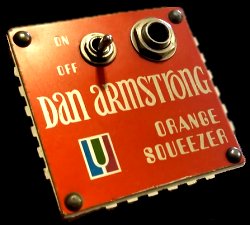
|
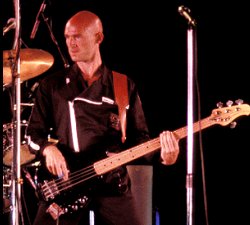
|
At left, the next effect has a bit more history to it than the others. This unit was to be a variant of the Green Ringer that
would produce notes an octave lower than the note being played. But unlike the Ringer, the octave only extended downward, and
it was possible to mix the effect along with the original note, or just use the effect alone. This effect was going to be called
the Orange Divider.
However, and for whatever reasons, this effect would eventually go through extreme changes in directions, to the point that even part of
its name changed. Ironically, it would become one of their most popular effects devices in the line. Named the Orange Squeezer, it is a
compressor that amplifies quieter signals more than loud ones, so that there is not much difference between the loud and soft notes. It can
be heard on countless recordings by Dire Straits, Steely Dan, and many others. At right, bassist Tony Levin in 1980 onstage with
Peter Gabriel, with a Dan Armstrong Orange Squeezer plugged into his bass.
The last two units in the line were really not effects devices. The Silver Shifter was basically a junction box that would take an incoming
signal and feed it to one or two outputs via a switch. The Black Blank was just an empty box that came complete with an input jack, a plug and
a switch, that allowed custom effects builders the ability to make their own devices that matched the other boxes in the series.
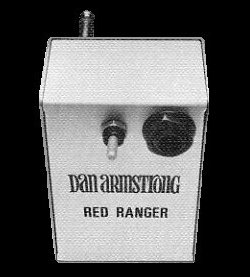
|
Craig Buzzart was not only Dan's long time friend, but also the North American distributor for the Dan Armstrong
'London' series guitars and basses, as well as the Dan Armstrong amplifiers and effects pedals who goes on to state
"at one point I had a small garage totally full of Dan Armstrong London type instruments as I was using the garage
as a warehouse."
In the various brochures and literature for the Dan Armstrong London instruments, the new Dan Armstrong effects units were being
listed as well. This literature can be seen in the brochures section. The effects units shown in that literature has
been copied and is shown here at left.
|
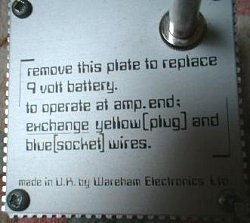
|
However, according to Craig, "the effects units shown in the 'London' guitar flyers and brochures are not the type
that would actually get marketed. Once they were put into production they were manufactured by a company called Wareham."
After looking over the prototypes, Wareham took Dan's and George's circuitry and installed it into one of their own
specially designed boxes.
As seen at left, the Wareham name is clearly visible at the bottom, as well as the place of manufacture - UK.
|
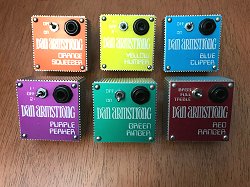
|
The entire line of Wareham effects units. Notice the Silver Shifter and the Black Blank are missing. It must, however, be remembered that
those two units are not 'effects' but rather empty boxes for the 'do-it-yourself' effects builders.
|
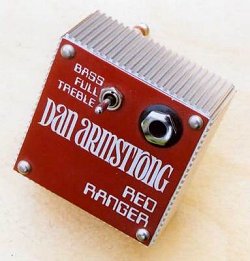
|
Their cases are made of aluminum and as can be seen at left the outer sides feature interlocking tabs. These tabs were
considered helpful in a studio type situation or any scenario where several of the different effects could be stacked
alongside &/or on top one another - with the tabs helping to more/less lock everything together and preventing the
units from sliding all over.
These units were available from 1973-77 in England and were marketed by a company called Sound Projects who's
advertizing literature can be seen in the brochure section.
|
At one point, according to Dan "an MXR rep tried out the Blue Clipper at a NAMM show and was amazed, not only of the
sound we got out of it, but also how we managed to fit everything into such a small package". Dan continues stating
" not too long after that they more/less copied the Clipper and went on to produce the 'Distortion Plus' which was their
version of the Clipper, but it wasn't as smooth as ours".
When I asked Dan about all the copying that was going on he replied "well, it's true that many copied our work or
our ideas, but it's also true that we borrowed ideas from others as well. The Green Ringer & Red Ranger, for instance
are built on the ideas of others. We just made it so that the effects work the way they should have. That was our goal
all along - to make effects that work right. There was a lot of copying going on, I know. The effects market was
really nothing more than a bunch of beggers and theives, all building off one anothers work. The trick was to get the
effects working and sounding right - then they sold".
MXR was not the only company to take notice of the Dan Armstrong effects units. The other company was Musitronics, the
same group that had made the famous MuTron effects pedals. While the MuTron effects units were popular the company was
not making much profit off of them simply because the units were so expensive to build. In brief, Musitronics was
looking for some partners to help offset some of the high cost of the MuTron pedals.
Craig Buzzart goes on to add "Dan Lamb and I were both reps for Mutron & he had heard of Dan's devices from Elliott
Randall - guitarist of Steely Dan and later - studio musician. Together, Dan Land and I negotiated the licensing
deal between Dan Armstrong and Musitronics. I remember introducing Dan to everyone, from which they made an agreement
to produce the Dan Armstrong effects units in the US" There were some differences however. For starters, there
were only five effects units to be produced in the beginning: the Red Ranger, Yellow Humper, Blue Clipper, Green
Ringer and Purple Peaker. But later, after a great deal of work, Mike Beigel, Dan Armstrong & George Merriman came out
with the Orange Squeezer - a compressor, limiter that would become one of the most popular units in the lineup. So
popular was it, that Wareham - which was still producing the effects units overseas, eventually changed one of
the original units as the Orange Divider soon got changed to the Orange Squeezer, like the Musitronics unit.
While the credit for the unit itself was shared by all parties at Musitronics, the Mutron website reveals that Mike
Beigel came up with the Orange Squeezer name. In all fairness, and as mentioned above, it's worth pointing out that
the Dan Armstrong 'London' guitar & bass brochures - printed a few years prior when Dan was still in England, lists
one of Dan's & Georges units called the 'Orange Divider' which would seem to suggest that Dan & George came up with at
least part of the name. In any case, the important thing is that the unit performed well and has become the most
popular of all the Dan Armstrong units.
In essence, only 6 of Dan's & Georges 8 units were produced by Musitronics, as they changed the 'Orange Divider'
to the 'Orange Squeezer' and they dropped the 'Silver Shifter' and the 'Black Blank' altogether. These changes were
only the beginning as according to Craig Buzzart "the original Wareham units were made so much better than anything
that came along afterwards. They had more heft to them as they were built from better materials. They also featured many
more interlocking tabs on them which in turn makes them more sturdy when stacked."
When it came time for the units to be produced in the US by Musictronics, Craig continued, stating "Aaron Newman
didn't want to spend the funds for the die to make the cases like Wareham and so they just used what they had."
Soon the stores were stocking the Dan Armstrong effects units in display cases like the two seen above.
continue
menu
Names and images are TMand © Dan Armstrong / Ampeg. All rights reserved.
All other names and images are TMand © of their respective owners. All rights reserved.
|
| |

